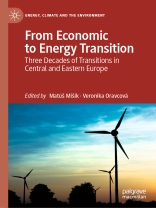This book examines energy transition issues within the Central and Eastern European (CEE) region. The European Union is aiming for an almost complete decarbonization of its energy sector by 2050. However, the path towards a carbon-free economy is full of challenges that must be solved by individual EU members. Across 18 chapters, leading researchers explore challenges related to energy transition and analyse individual EU members from Central and Eastern Europe, as well as the region as a whole. To further explore this complex issue, the volume also includes several countries from South East Europe in its analysis. As perspective members, these countries will be important contributors to the EU’s mid- and long-term climate and energy goals. The focus on a variety of issues connected to energy transition and systematic analyses of the different CEE countries make it an ideal reference for anyone with a general interest in the region or European energy transition. It will alsobe a useful resource for students looking for an accessible overview of the field.
Table of Content
Chapter 1. Introduction: Central and Eastern European perspective on energy transition.- Part I. ENERGY TRANSITION CHALLENGES.- Chapter 2. From economic transformation to energy transition. The legacy of 30 years of postcommunist development.- Chapter 3. The CEE Energy Transition: Recurring 50 year old dynamics?.- Chapter 4. Tunnel With No Light: Entrapment and ‘Exit’ of V4 Countries’ Energy Transition.- chapter 5. Public attitudes to sustainable energy transitions in the Visegrad four: historical legacy and emerging trends.- Chapter 6. Structural Changes in the Baltics and the Russian Presence: Ramifications for the Region’s Energy Future. Chapter 7. Women as change agents of the Bulgarian energy transition.- Part II. DIFFERENT PATHS TO ENERGY TRANSITION.- Chapter 8.
Pathways for a low-carbon electricity system in Poland and Hungary.- Chapter 9. Slovenia: Drivers and Challenges of Energy Transition to Climate Neutrality.- Chapter 10. Energy transformation in Lithuania: Aiming for the grand changes.- Chapter 11. Between Energy Security and Energy Transition: Visegrad Gas Hub.- Chapter 12. Path-dependencies of carbon lock-in shaping coal phase-out in Poland’s electricity sector: A herculean task of decarbonization?.- Part III. LEGAL AND POLITICAL ASPECTS OF ENERGY TRANSITION.- Chapter 13.
The CEE countries and the European Union’s energy transition: Economic analysis of law.- Chapter 14. The role of the Court of Justice of the European Union in the reformulation of Hungarian energy policy. Chapter 15. Perfect compliance? Nuclear power in Central and Eastern Europe and the EU membership. Chapter 16. Energy-transition challenges in the Baltic Sea Region: an overview of socio-political and legal gaps.- Part IV. VIEW FROM THE NEIGHBOURHOOD.- Chapter 17.
Energy security pathways in South East Europe: Diversification of the natural gas supplies, energy transition, and energy futures.- Chapter 18. Transition to electricity from renewables in line with the EU standards in Serbia:Integration with(out) membership and inconsistent implementation.- Chapter 19. A light at the end of a tunnel or a freight train? A comparative analysis of energy transition in Croatia and Serbia.- Conclusion: Halfway between economic and energy transition
About the author
Matúš Mišík is Assistant Professor at the Department of Political Science at Comenius University in Bratislava. His main research interests include energy security in the EU and the role of perception within EU decision-making mechanisms. He is the author of External Energy Security in the European Union (2019) and has published articles in major energy policy journals.
Veronika Oravcová is Research Assistant at the Department of Political Science at Comenius University in Bratislava and Research Fellow at the Slovak Foreign Policy Association. Her research interests are centered on energy transition and energy security in Central and Eastern Europe.












